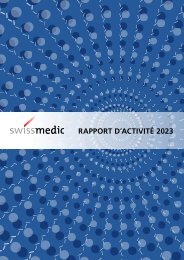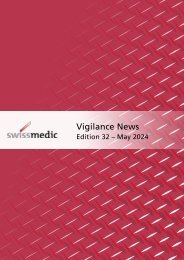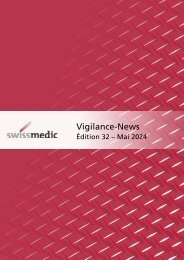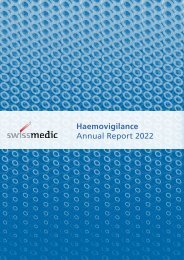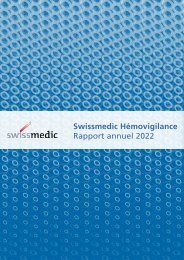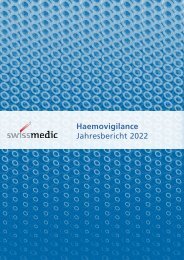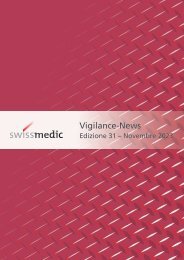Swissmedic Vigilance News
Edition 31 – November 2023
Edition 31 – November 2023
You also want an ePaper? Increase the reach of your titles
YUMPU automatically turns print PDFs into web optimized ePapers that Google loves.
Among those cases in which drug causality was retained,<br />
five out of the seven patients had at least<br />
one comorbidity predisposing them to the onset of<br />
pancreatitis, and five out of seven had at least one<br />
risk factor for acute or drug-induced pancreatitis.<br />
In three cases, the suspected drugs were classified<br />
in category Ia according to Wolfe et al. (2020), i.e.<br />
at least one case report with a positive rechallenge,<br />
consistent latency and other causes having been<br />
ruled out. In one case the suspected drug was classified<br />
in category II. Finally, the suspected drugs in<br />
the last three cases were not included in the classification<br />
tables for assessing the association with<br />
drug-induced pancreatitis (4–6).<br />
Discussion<br />
As mentioned in the introduction, cases of druginduced<br />
pancreatitis are rare. Their progression is<br />
usually benign, but they can become life-threatening<br />
in isolated cases. Therefore, a knowledge of<br />
those drugs capable of triggering pancreatitis can<br />
be useful for clinicians and enable them to identify<br />
this rare aetiology and, most importantly, refrain<br />
from re-administer the implicated drugs to their<br />
patients.<br />
In February 2023, drug-induced pancreatitis was also<br />
the subject of a new section, "Pharmacovigilance in<br />
the spotlight", published on the <strong>Swissmedic</strong> website<br />
(7). This section presents three case reports involving<br />
isotretinoin (class II), azathioprine (class Ia)<br />
and semaglutide (not classified) (4). It serves as a<br />
reminder that this adverse drug reaction should be<br />
considered in the differential diagnosis as a possible<br />
cause of acute pancreatitis.<br />
The determination of drug causality in cases of<br />
pancreatitis can be complex to establish. Similar to<br />
other adverse drug reactions, it involves an exclusion<br />
diagnosis, and it is advisable to first rule out<br />
other potential causes such as biliary (gallstones) or<br />
alcoholic aetiology, paying particular attention to<br />
their frequency (1). A biliary origin should be suspected,<br />
particularly if the transaminase levels are<br />
abnormal. In elderly patients, obstruction of the<br />
pancreatic ducts by a tumour should be considered,<br />
although this scenario is rare. In young patients, an<br />
infectious origin should be explored systematically.<br />
Other aetiological causes that should also be taken<br />
into account include hypertriglyceridaemia, autoimmune<br />
factors, hyper/hypocalcaemia, a malignant<br />
tumour, a genetic cause, a complication of endoscopic<br />
retrograde cholangiopancreatography, and<br />
trauma (8).<br />
Alongside the aetiological investigations, the<br />
chronology of the symptoms in relation to the<br />
start of the implicated drug, the clinical outcome<br />
upon discontinuation and the results of biological<br />
tests are also useful in establishing the diagnosis. It<br />
should be noted, however, that a latency of several<br />
months does not rule out a drug-related aetiology.<br />
The drugs implicated in the cases reported to RPVC<br />
Geneva include treatments that are commonly<br />
known to be associated with the onset of acute<br />
pancreatitis, such as metronidazole, paracetamol/<br />
codeine and valproate, as well as ceftriaxone, although<br />
the acknowledged association with the<br />
latter is considered to be less strong. The three<br />
other cases involve anti-diabetic drugs that were<br />
recently placed on the market and that are therefore<br />
not yet included in the various classification<br />
systems: semaglutide (a glucagon-like peptide 1<br />
analogue [GLP1]), empagliflozin and dapagliflozin<br />
(sodium-glucose transport protein 2 inhibitors<br />
[SGLT-2]), although it should be noted that drugs<br />
belonging to the same classes – liraglutide and<br />
canagliflozin – are already classified in category Ic.<br />
In fact, several case reports involving the use of<br />
GLP-1 receptor agonists can be found in the literature<br />
(9–13), and acute pancreatitis is listed as an<br />
uncommon adverse reaction (≥1/1,000,




